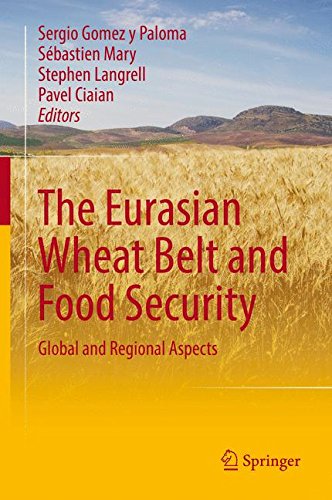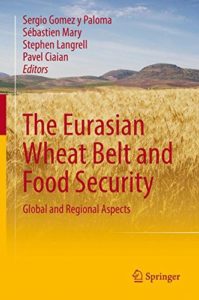
The Eurasian Wheat Belt and Food Security: Global and Regional Aspects by Sergio Gomez y Paloma, Sébastien Mary, and Stephen Langrell

The problem of global food security was brought into sharp relief in 2008-2011 in food riots in the global south and the Arab Spring. These crises witnessed a sharpening of debate about how to feed the world. Advocates of the traditional food security approach maintain that the answer lies in “aid and trade” based on the world-price-governed staple food circuits that emerged in the twentieth century, and large-scale, high external-input corporate farms. This view is challenged by “food sovereignty” advocates who, drawing attention to the negative environmental, social and food-safety impacts of large-farming, insist that the answer lies with backing the small producer, shortened value-chains, and regional markets. The “peasant path”(La Via Campesina), so activists argue, offers an alternative agrarian future that, at the same time as feeding people and sustaining rural communities, “cools down the earth.” Here is not the place to discuss the arguments of the sides in this highly polarized debate, but the reason I raise it here is to observe that The Eurasian Wheat Belt and Food Security: Global and Regional Aspects, is firmly situated in the first of the above food security paradigms.
This collection is not for anyone interested in how wheat entering the global market from Eurasia is cultivated, or the role of wheat monoculture in national and local economies and its environmental and social impacts. The eighteen papers making up the volume were delivered at a workshop in Istanbul in spring 2014, held under the auspices of the European Commission. The workshop’s aim was to discuss the potential of the three principal wheat producing successor states of the Soviet Union – the Russian Federation, Ukraine and Kazakhstan (the RUKs) – to expand their share in the global wheat export market and to evaluate Eurasia’s future contribution to “international concerted efforts to secure reliable sources of cereal production.” The papers are policy-orientated, technical, and quantitative. Together, they show that Eurasia is on track to overtake the USA as the leading global wheat exporter, but how great the lead will be depends upon freeing producers from domestic regulatory constraints, increasing investment into large farming and trading infrastructure, de-politicising agrarian policy, and the resolution of series of country-specific problems.
The book in divided into four parts. The first is contextual, describing the policy, commercial and institutional context for the discussions that follow. These focus, in part two, on how land reform and agrarian policies have played out in each of three major wheat producing countries in Eurasia; in part three, on the prospects for expanded wheat production in Russia, Ukraine and Kazakhstan and their traditional cereal importing neighbors in Central Asia; and in part four, on Eurasia’s future contribution to the global wheat market compared with other BRICs. As is often the case with conference proceedings, The Eurasian Wheat Belt and Food Security suffers from problems of repetition, unevenness between chapters and conceptual and terminological lack of consistency, the most egregious example of the last being in the nomenclature of (the admittedly confusing number of) different farm types that emerged from the collapse of the Soviet socialized farm system. There are also some shortfalls in presentation and confusions for the general reader that Springer’s editors should have picked up, such as those arising from the three tone coloration of figures – I am still puzzling over how the colors and farm-types match up in figures 5 and 6. These aside, there is a welcome coherence to the papers in the volume that is unusual for an edited collection. This reflects the authors’ shared assumption about the existence of a large “yield gap” in the main cereal producing countries of Eurasia.
The hypothesis is that Soviet agricultural inefficiency, the natural corollary of centralized planning and social ownership, meant that there were large production gains to be had once that system was supplanted by capitalism. The belief that communism’s ending would bring with it a “production dividend” attracted foreign direct investment into the agriculture sector, but despite the application of the latest Western technologies, the promise of easy profits was soon disappointed. This “early warning” of problems ahead is overlooked by the contributors to this volume who, instead, draw attention to the expansion of wheat production and doubling of Eurasia’s contribution to the global wheat market since the recovery from the catastrophic lows of the early transition years. Twenty years on from communism’s collapse they insist that there is still slack to be taken up in agricultural production. They base their optimism on the low average yields in Eurasia compared with competitors and large tracts of land abandoned in the 1990s that are yet to be returned to production. The task is to address the obstacles that have to date frustrated the closing of the production- and yield-gap.
The majority of chapters focus on three major wheat producers, although their post-Soviet agrarian history is placed in the context of the whole of post-Soviet space. The early papers, authored by well-established specialists on agrarian reform such as V. Ya Uzun, N. I. Shagaida, and Zvi Lerman, consider the agrarian and land reforms promulgated in the decade after 1991, which aimed to create domestic farm structures that would allow each successor state to take advantage of land privatization and/or farm individualisation. The country-specific features of the reforms are described in detail. Successive papers tell the familiar story of the reforms’ partial failures including the carry over from Soviet times of a dualistic farm structure in Russia and Ukraine, the over-concentration and/or excessive fragmentation of land, complicated bureaucratic and legal regimes in relation to land rights, underinvestment in infrastructure and the absence of well-functioning credit and finance systems. Where the contributors to this volume depart from most other analyses, is their optimism about the prospects for these problems being resolved in the near to medium future.
There are hints in the second half of the volume in parts three and four, that some of the obstacles reproducing the production- and yield-gap in the past two decades might be difficult to overcome. When estimates of the quality and quantity of abandoned land that can be restored to production and the costs of intensification factored in, the prospects for large increments in wheat production begin to look complicated. Agro-climatic resources are not helpful. I recall the late geographer Paul Lydolph, in his classic undergraduate text, making the simple, but still valid point, that it is important to remember that Russia is a northern, continental country, which means that it is always going to fall behind its principal competitors in cereal production. The problem lies in the heat-moisture balance and distribution of soils. In the USA, agro-climatic zones run longitudinally north-south. In Eurasia, by comparison, agro-climatic zones are latitudinal; Ukraine and Russia’s most fertile soils, the black earths, are situated in regions with an unfavorable heat-water balance. Low rainfall during the growing season and high rainfall in the months of harvest, are compounded in the southern steppe by the openness of the country to hot, dry winds from Central Asian deserts. Further to the east, in the interior of the landmass, droughts can be expected every two-three years out of five. The prime wheat producing regions of RUK, in other words, are extremely vulnerable to inclement weather. And all of this, as one of the papers shows, is before the future impact of global warming is taken into account, which is set more or less to eliminate wheat growing from Kazakhstan. Environmental constraints, therefore, place question marks over the potential for the re-cultivation of abandoned land and the application of intensive methods to make the sort of increments to production that policy makers are hoping for. One of the strongest papers in the collection analyzes the negative impact of harvest uncertainties on wheat prices, a problem that can only become more pronounced as the share of Eurasia in the global market increases.
The papers about RUK raise fundamental questions about the wisdom of these states pursuing cereal-first polices, not least when this involves marketing poor quality wheat. They are also a reminder that there is a political dimension to the issues surrounding food security. In 2014, when the conference in Istanbul took place, Russia had already imposed sanctions on the import of food products from countries supporting Ukraine and its food security program that aims to make Russia near self-sufficient in food by 2020 was in its fourth year. The paper in the collection on the development of the Eurasian livestock industry demonstrates particularly well the dilemmas for the Russian Federation as a result of the simultaneous pursuit of food self-sufficiency and maximizing wheat export. The political dimension is uppermost in two papers considering wheat production in countries of Central Asia, while the role of population dynamics in balancing domestic demand for cereals against export earnings, is discussed in the two papers at the end of the collection about China and India.
In the introduction, the editors state that one of their aims is to counter the predominantly pessimistic view of agriculture that dominates the literature on Eurasian farming. It is true that the Western literature is, on the whole, negative and the volume under review is a helpful corrective. However, I regret that the authors did not engage more directly with the pessimistic, or as I prefer, more measured view that can be found in the works of Alexandr Nikulin and Tatyana Nefedova in Russia, and Stephen Wegren, O’Brien and O’Brien, Visser, Spoor and Mamanova, among others, in the West; it is surprising that these specialists hardly get a mention. Leaving aside the environmental constraints, there is little hint from the authors in this volume of the mountain left to climb to close the production gap. Of the nine policy options listed in the conclusion “to improve rural productivity and food security,” I struggle to find one that could be easily implemented in the short-term, while the implementation of some would call for major domestic political and geopolitical change. I should have liked to know how confident the authors are that there will, indeed, be a speedy completion of the land reform process, that Russia will soon refrain from placing barriers to trade or using export restrictions, that an equitable support system for all producers large and small will be implemented, that land will be redistributed from large to small farms, that access to credit financial institutions will be improved across the farming sector, transport and logistics modernized, and so on. I also missed a discussion of how these policy recommendations might be made to fit into a more diversified approach to rural development that gives as much weight to social welfare and the environment, as to production. Returning to my observations at the beginning, food security can be achieved in different ways. The contributors to this volume are convinced that deregulation, wheat monoculture, and high external-input farming methods on large corporate-type farms is the way forward. As such, The Eurasian Wheat Belt and Food Security fills a geographical gap in the literature on the traditional food security paradigm. Whether it makes the case for this being the appropriate way forward for Eurasia or, indeed, for people elsewhere in the world suffering food insecurity is another matter entirely.
Reviewed by Judith Pallot, University of Oxford
The Eurasian Wheat Belt and Food Security: Global and Regional Aspects
by Sergio Gomez y Paloma, Sébastien Mary, and Stephen Langrell
Publisher: Springer
Hardcover / 322 pages / 2016
ISBN: 978-3-319-33239-0
To read more book reviews, please click here.
Published on December 6, 2017.




